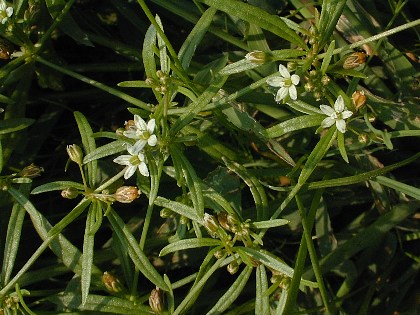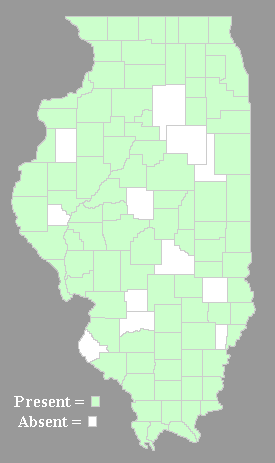Description: This plant is a prostrate summer annual, branching at the base and forming a more or less circular mat up to 5" high. The stems are glabrous and either round or angular, occasionally forming side stems. There are whorls of 3-8 leaves at intervals along the stems. These leaves are up to 1½" long and ¼" across. They are linear or linear-oblanceolate, smooth along their margins, and hairless.

From the axils of
the leaves, there are small whorls or clusters of 2-5 flowers. Each
flower is about ¼" across, consisting of 5 petal-like sepals, no
petals, 3-5 white stamens, and a large green ovary with a tiny
tripartite style on top. The sepals are white or greenish white, often
with pale green lines. The stamens are usually appressed against the
walls of the ovary. The blooming period occurs from mid-summer through
the fall, and lasts about 2 months. There is no noticeable floral
scent. Each flower matures into a 3-valved seed capsule. Each valve of
the capsule contains numerous small seeds that are reddish brown,
shiny, and reniform. There are small ridges along the sides of the
seeds, but they are hard to see without a magnifying glass. The root
system consists of a taproot. This plant spreads by reseeding itself,
and often forms colonies.
 Cultivation:
This plant is typically found in full or partial sun, mesic to dry
conditions, and sandy soil, although it can occur in other kinds of
soil as well. Open disturbed sites are preferred because it is not
competitive with taller vegetation.
Cultivation:
This plant is typically found in full or partial sun, mesic to dry
conditions, and sandy soil, although it can occur in other kinds of
soil as well. Open disturbed sites are preferred because it is not
competitive with taller vegetation.
Range & Habitat:
Carpetweed is a fairly common plant that occurs in most counties in
Illinois. Habitats include lawns and gardens, construction sites,
fields, areas along roadsides and railroads (including the ballast),
disturbed sandy meadows, and waste areas. This species is adventive
from tropical America.
Faunal Associations:
The nectar and pollen of the flowers attract Halictid bees and various
flies, including Syrphid flies, flesh flies, and Muscid flies.
Otherwise, there is little information available about floral-faunal
relationships for this species in Illinois and adjacent areas. In the
desert southwest, foliage and seeds of a carpetweed species are
sometimes eaten by small rodents, including kangaroo rats.
Photographic Location:
Recently disturbed soil at a construction site in Meadowbrook Park,
Urbana, Illinois.
Comments:
Sometimes Carpetweed is classified in the Aizoaceae,
rather than Molluginaceae. This is one of the few
species of prostrate plants with whorled leaves and flowers, which
makes this species fairly easy to identify. While the Galium
spp. (Bedstraws) are sprawling plants with whorled leaves,
the corollas of their flowers have 4 lobes, rather than 5. Each flower
of the Bedstraws has a pair of round ovaries that lie underneath the
corolla, while each flower of Carpetweed has a single oval-shaped ovary
that projects above the petal-like sepals. Carpetweed is glabrous
throughout, while the Bedstraws often (but not always) have clinging
hairs on their foliage and seed capsules.